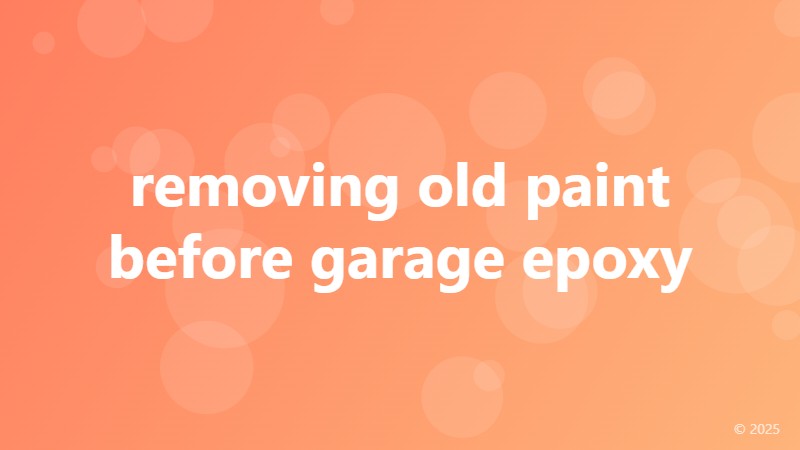removing old paint before garage epoxy
 ```html
```html
Why Removing Old Paint Before Garage Epoxy is Crucial
Applying epoxy coating to your garage floor is a fantastic way to transform its look and dramatically increase its durability. However, skipping a crucial step – properly removing old paint – can lead to a disastrous result. A successful epoxy flooring project starts with a clean, sound surface. Old, flaking paint is the enemy of a long-lasting, beautiful epoxy finish. This article will delve into why removing old paint is paramount before applying your garage epoxy and guide you through the best methods for achieving a pristine surface ready for your new flooring.
The Problems of Epoxy Over Old Paint
Applying epoxy directly over old, peeling paint is a recipe for disaster. Here's why:
- Poor Adhesion: Epoxy needs a clean, sound surface to adhere properly. Old paint, especially if it's cracked, chipped, or peeling, provides a poor bonding surface. This means your beautiful new epoxy floor could peel, chip, or blister within weeks or even months of application.
- Uneven Surface: Old paint often has an uneven texture. This unevenness will translate to your epoxy coating, resulting in an unsightly and potentially unstable finish. You'll end up with a floor that looks bumpy and unprofessional.
- Contamination: Old paint can contain various chemicals and contaminants that can interfere with the curing process of the epoxy, weakening the bond and compromising the overall durability of the coating. This can lead to premature failure of your epoxy floor.
- Hidden Problems: Applying epoxy over old paint can mask underlying issues with the concrete, such as cracks or moisture damage. These problems will likely worsen over time, leading to further issues with your epoxy floor.
Methods for Removing Old Paint from Your Garage Floor
Several methods exist for removing old paint, each with its own pros and cons. The best method will depend on the type of paint, its condition, and the size of your garage floor.
Mechanical Removal
This involves physically scraping or sanding the old paint off. For smaller areas or stubborn paint, a scraper and wire brush can be effective. For larger areas, a power sander with appropriate sanding pads is a more efficient option. Remember to wear appropriate safety gear, including a respirator to avoid inhaling dust and paint chips.
Chemical Removal
Chemical paint strippers are another option. These are applied to the paint, allowing it to soften and then be scraped away. Always follow the manufacturer's instructions carefully, as these products can be harsh and require good ventilation. Remember to protect your skin and eyes with appropriate safety gear.
Sandblasting
For very stubborn paint or large areas, sandblasting can be a highly effective but more involved method. This requires specialized equipment and expertise; it's usually best left to professionals. Sandblasting creates significant dust, so adequate safety precautions are crucial.
Preparing the Surface After Paint Removal
Once you've removed the old paint, it's crucial to properly prepare the concrete surface before applying epoxy. This includes:
- Thorough Cleaning: Use a pressure washer or a stiff brush and detergent to remove all traces of paint, dust, and debris.
- Concrete Repair: Repair any cracks or damage to the concrete using a suitable patching compound.
- Etching: Etching the concrete with an appropriate etchant will create a porous surface that allows for better epoxy adhesion.
- Priming (Optional): A concrete primer can further enhance adhesion and help prevent future problems.
Choosing the Right Epoxy for Your Garage
Selecting the correct epoxy is just as important as preparing the surface. Consider factors like durability, UV resistance, and chemical resistance when making your choice. Consult with a professional supplier for advice on selecting the best epoxy for your specific needs and garage environment.
Conclusion: Invest in Proper Preparation for a Long-Lasting Epoxy Floor
Removing old paint before applying garage epoxy is not just a recommendation; it's a necessity. Investing the time and effort in proper surface preparation will ensure a beautiful, durable, and long-lasting epoxy floor that you can enjoy for years to come. Skipping this crucial step can lead to costly repairs and disappointment down the line. Choose the right method for your garage and follow the steps outlined above for a successful epoxy flooring project.
```